
Security News
TC39 Advances 11 Proposals for Math Precision, Binary APIs, and More
TC39 advances 11 JavaScript proposals, with two moving to Stage 4, bringing better math, binary APIs, and more features one step closer to the ECMAScript spec.
APCA: the Accessible Perceptual Contrast Algorithm, a modern contrast method that improves readability contrast on self-illuminated displays. Developed for the W3C's WCAG 3 and other standards.
APCA is the Accessible Perceptual Contrast Algorithm, a new way to predict contrast for text and non-text content on self illuminated displays.



APCA is a contrast assessment method for predicting the perceived contrast between sRGB colors on a computer monitor. It has been developed as an assessment method for W3 Silver/WCAG3 accessibility standards relating to content for computer displays and mobile devices, with a focus on readability and understandability.
The APCA version in this repositiory is licensed to the W3/AGWG per the collaborative agreement with specific limitations and exclusions. Please see the license file for details.
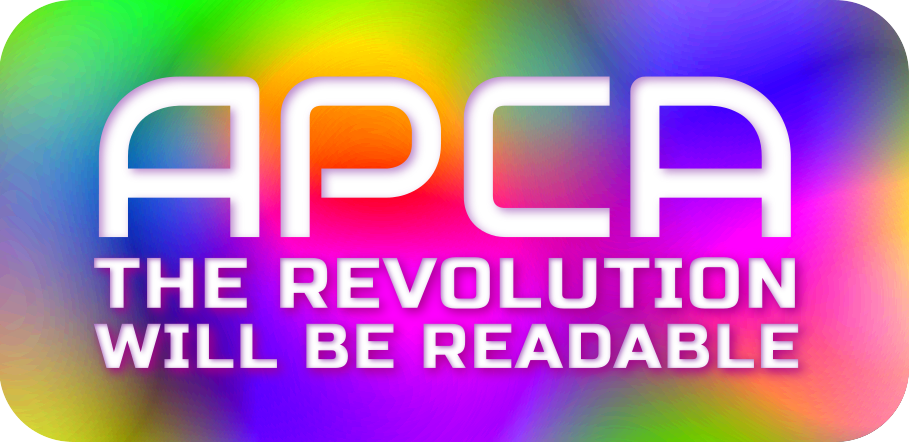
Visit git.myndex.com for a catalog of resources, including articles, third party and peer reviews, additional documentation, white-papers, and more.
For comments and discussions, please see the main SAPC-APCA repo, discussion area. This is also where we discuss draft guidelines and proposals. Please post all comments or discussions there and not in the satellite repositories so they can be tracked and resolved.
There is a working version with examples and reference material on the APCA demo tool site
npm i apca-w3
<script type="module">
import { APCAcontrast, reverseAPCA, sRGBtoY, displayP3toY, adobeRGBtoY, alphaBlend, calcAPCA, fontLookupAPCA } from 'apca-w3';
import { colorParsley, colorToHex, colorToRGB } from 'colorparsley'; // optional string parsing
</script>
If you need to parse a color string or 24bit number, use the colorParsley() function:
let rgbaArray = colorParsley('aliceblue');
Intended for blending the foreground color into the background. Only the foreground has an alpha. There is no conversion to linear space, so blending takes place is the working colorspace, as is standard.
// Send 0-255 arrays alphaBlend(FG, BG)
let alphaBlended = alphaBlend([0,0,0,0.6],colorParsley([255,255,255])),
// Send 0-1.0 float arrays for displayP3toY, 5th element
// is bool (false for floats): alphaBlend(FG, BG, false)
let alphaBlended = alphaBlend([0.7,1.0,1.0,0.33],colorParsley([0,0,0]),false);
Send rgba INT array [123,123,123,1.0] to sRGBtoY() — this is a slightly different luminance Y that the IEC piecewise.
let Ys = sRGBtoY([123,123,123,1.0]);
Note that for for sRGB and Adobe98, the values in the array must be 0.0-255.0 per CSS4 specs, but for displayP3toY(), the values must be 0.0-1.0, per Apple and CSS4 specs.
First color must be text, second color must be the background.
let textColor = [17,17,17,1.0];
let backgroundColor = [232,230,221,1.0];
let contrastLc = APCAcontrast( sRGBtoY( textColor ), sRGBtoY( backgroundColor ) );
Example using everything together, including alphaBlend:
let colorTEXT = rgb(12,23,34,0.65);
let colorBG = #e6e0dd;
let Lc = APCAcontrast(sRGBtoY( alphaBlend(colorParsley(colorTEXT), colorParsley(colorBG)) ),
sRGBtoY( colorParsley(colorBG) ));
The long complete line shown above is aliased into a function calcAPCA(). Alpha for the text is automatically detected, and ignored if 1 or ''. The input type is also auto detected (string, king of string, number, array, object). By default returns a signed float -108.0 to 106.0 (approx)
let Lc = calcAPCA(colorTEXT,colorBG);
New in this version is an interpolated font size array. Send fontLookupAPCA(contrast) a contrast value, and it returns an array, with the contrast (Lc) as the zeroth element, then 9 font sizes in px corresponding to weights 100 thru 900:
['LcValue',100,200,300,400,500,600,700,800,900]
Example:
fontArray = fontLookupAPCA(-68.541);
console.log(fontArray) // -68.541,67,40,28,20.5,18.5,16.5,15,416,418
Thus the 400 weight font is indicating 20.5px
New in this version is a reverse contrast lookup. Specify a contrast, and one color (i.e. bg) and it will try to find a color with that contrast.
reverseAPCA (Lc, knownY, knownType = 'bg', returnAs = 'hex')
See the colorparsley package for documentation on the available string inputs.
colorParsley() is a dependency for the shorthand calcAPCA()
There are two extra parameters for calcAPCA(), and one extra for APCAcontrast.
calcAPCA( text, BG, places, isInt )
APCAcontrast ( txYs, bgYs, places = -1 )
alphaBlend( txt, BG, round(bool) )
places defaults to -1, but you can send it 0 and the Lc is returned as a rounded value, and instead of a minus sign for polarity, 'WoB' for white on black is returned.
isInt or round defaults to true, as we assume the RGB tuples are 0-255. If you are sending float such as for displayP3, then set ` isInt = false ``
NOTE: neither of these are "official" and may change, move, or vanish.

Beta testers may wish to include the following statement in their site's boilerplate:
This is the base algorithm version. The other version numbering as listed below are for the overall library file, relating to features and functions are added to aide in integration. These added features do not impact the base algorithm which is stable and undergoing public beta validation.
Current as of May 27, 2022
Notes on the lookups:
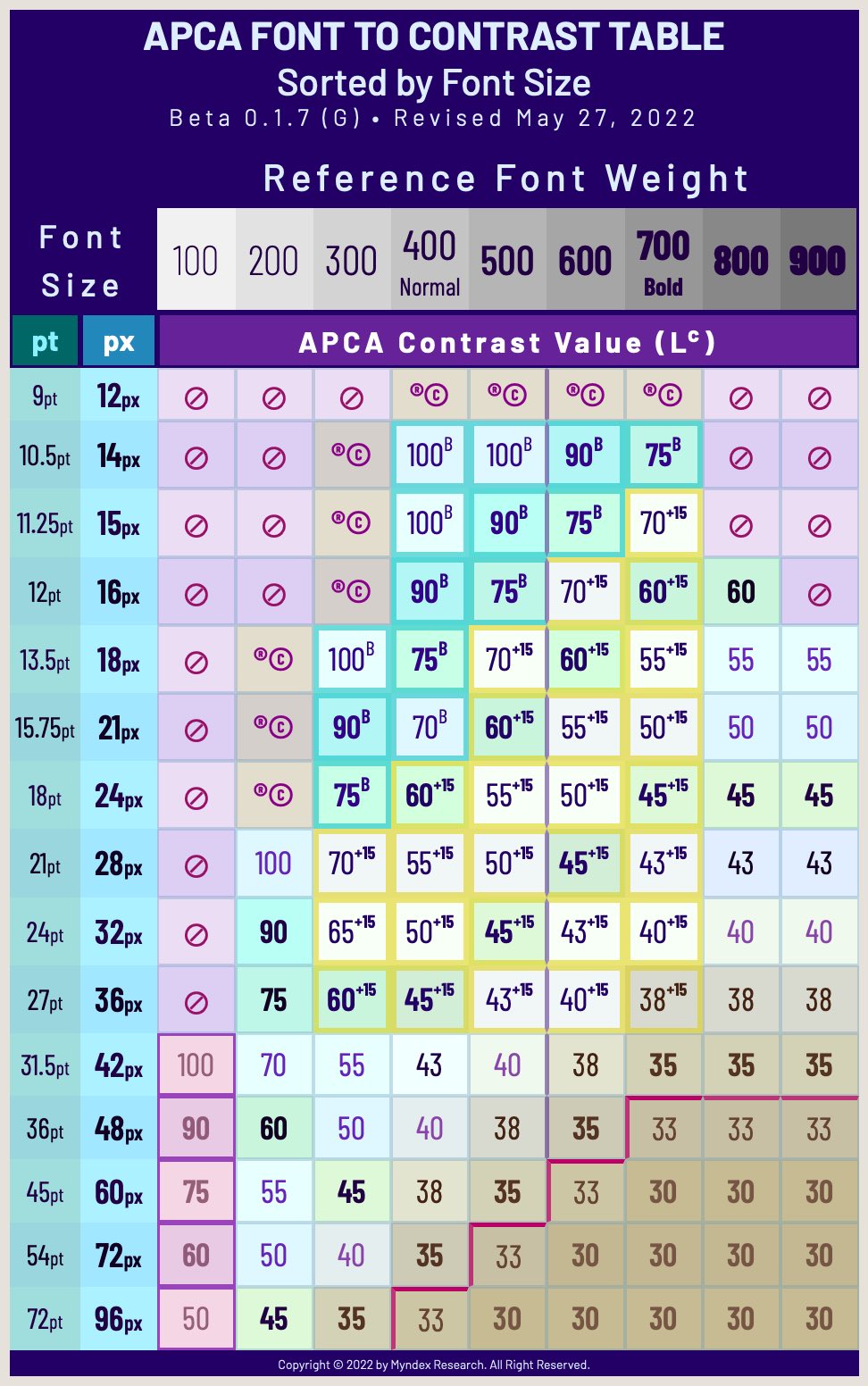
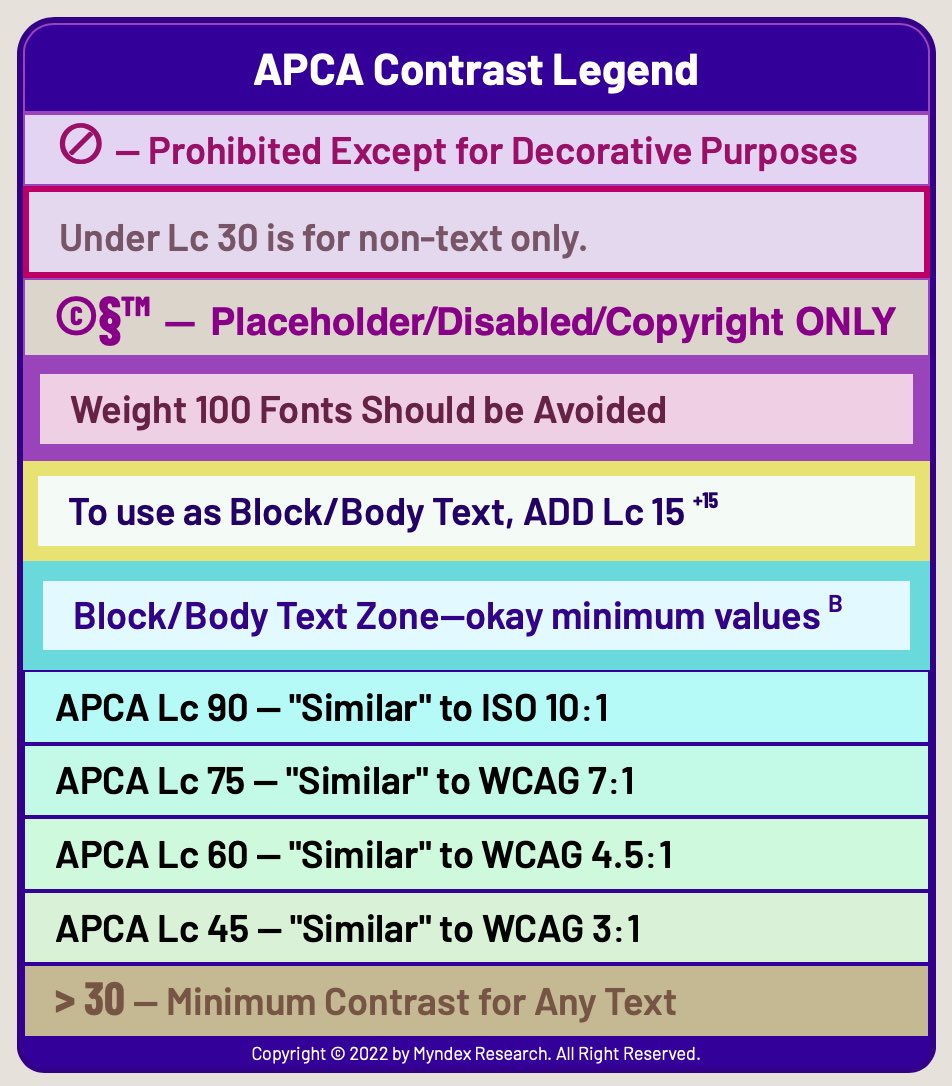
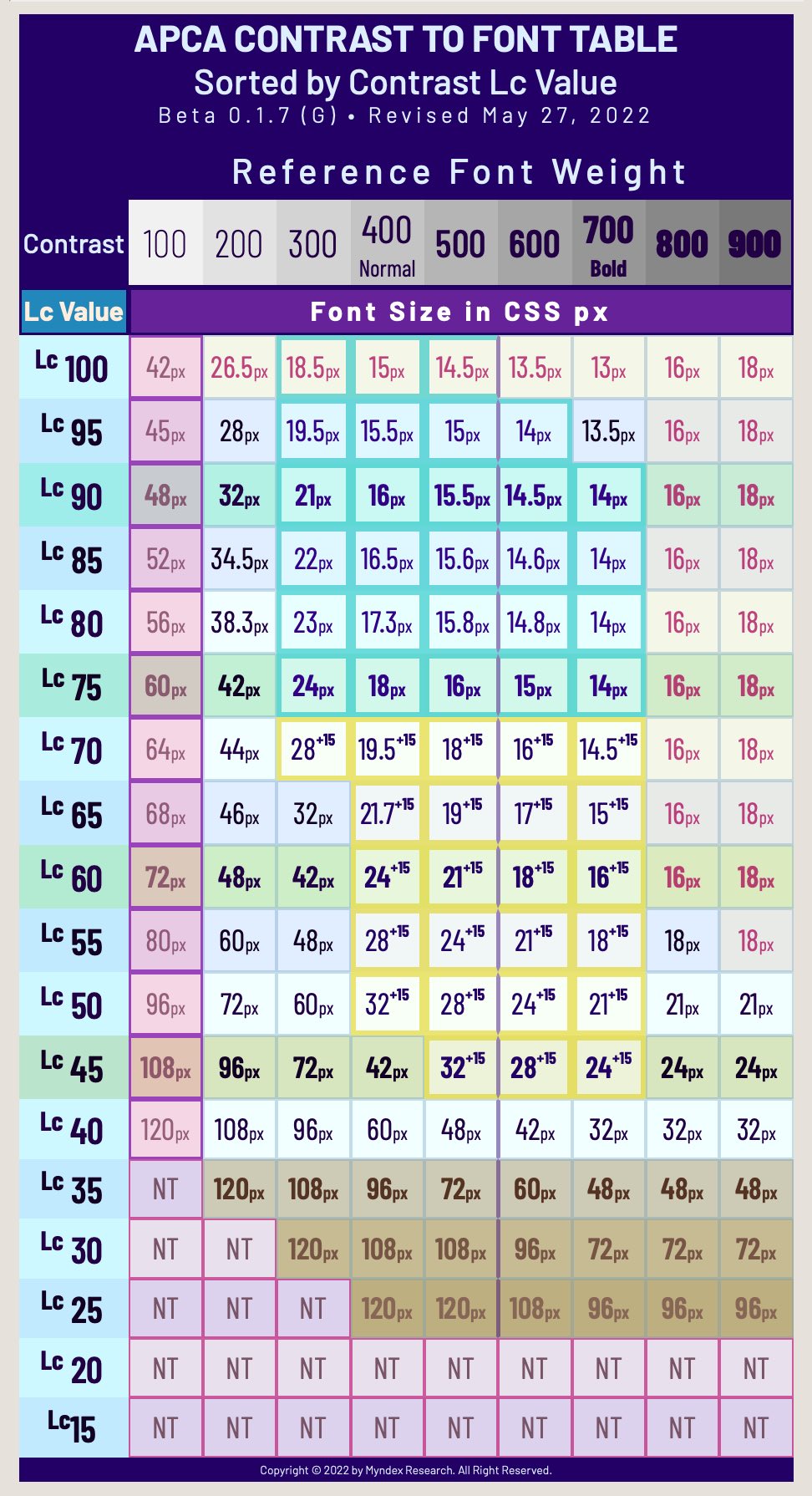
( 0.0.98G - W3 last changed Feb 15, 2021 )
These constants are for use with the web standard sRGB colorspace.
These are the current constants for use with current library version 0.1.9+
///// 0.0.98G - W3 constants (W3 license only): /////
//// These constants remain unchanged for apca-w3 ////
/// versions 0.1.0 (initial npm package) and later ///
// //
exponents = { mainTRC: 2.4, normBG: 0.56, normTXT: 0.57, revTXT: 0.62, revBG: 0.65, };
colorSpace = { sRco: 0.2126729, sGco: 0.7151522, sBco: 0.0721750, };
clamps = { blkThrs: 0.022, blkClmp: 1.414, loClip: 0.1, deltaYmin: 0.0005, };
scalers = { scaleBoW: 1.14, loBoWoffset: 0.027,
scaleWoB: 1.14, loWoBoffset: 0.027, };
// Note: loClip && deltaYmin do not affect lc in range & only clamp low Lc values
---------------------------------------------------------------------------
///// 0.1.1 Color space coefficients for P3 and Adobe /////
//// These are derived from the 1931 CIE standard observer ////
/// Using the equations found at BruceLindbloom.com ///
// And using the current CIE D65 //
///// Display P3: /////
const sRco = 0.2289829594805780,
sGco = 0.6917492625852380,
sBco = 0.0792677779341829; // displayP3 coefficients
// Derived from 1931 CIE xyY:
// xW yW K xR yR xG yG xB yB
// 0.312720 0.329030 6504 0.680 0.320 0.265 0.690 0.150 0.060
///// AdobeRGB: /////
const mainTRC = 2.35; // Pending further evaluation:
// 2.35 exponent to emulate actual monitor perception
const sRco = 0.2973550227113810,
sGco = 0.6273727497145280,
sBco = 0.0752722275740913; // adobeRGB coefficients
// Derived from 1931 CIE xyY:
// xW yW K xR yR xG yG xB yB
// 0.312720 0.329030 6504 0.640 0.330 0.210 0.710 0.150 0.060
---------------------------------------------------------------------------
///// 0.1.14G MAGIC NUMBERS for UNCLAMP, used only with reverseAPCA() /////
//// for use with blkThrs: 0.022 & blkClmp: 1.414 ////
const mFactor = 1.94685544331710;
const mFactInv = 1/mFactor;
const mOffsetIn = 0.03873938165714010;
const mExpAdj = 0.2833433964208690;
const mExp = mExpAdj / blkClmp;
const mOffsetOut = 0.3128657958707580;
npm testfontLookupAPCA(Lc) Live font lookup table — send it a contrast, it returns an array of font sizes (in px) for each of 9 weights (100 to 900).reverseAPCA(Lc,Y,use,returnAs) New in this version is a reverse contrast lookup. Specify a contrast, and one color (i.e. bg) and it will try to find a color with that contrast.This moved over the base APCA and G4g constants (from Feb. 15th, 2021) to an npm package.
Disclaimer: APCA is being evaluated as a replacement for WCAG 2 contrast math for future standards and guidelines, however, standards that will be incorporating APCA are still developmental. Because WCAG 2 contrast math does not accurately model human visual perception nor visual impairments, there will be discrepancies between WCAG 2 contrast math, and perceptually uniform models such as APCA. It is up to the end user to determine suitability of purpose for their region and conformance requirements.
FAQs
APCA: the Accessible Perceptual Contrast Algorithm, a modern contrast method that improves readability contrast on self-illuminated displays. Developed for the W3C's WCAG 3 and other standards.
The npm package apca-w3 receives a total of 27,715 weekly downloads. As such, apca-w3 popularity was classified as popular.
We found that apca-w3 demonstrated a not healthy version release cadence and project activity because the last version was released a year ago. It has 1 open source maintainer collaborating on the project.
Did you know?

Socket for GitHub automatically highlights issues in each pull request and monitors the health of all your open source dependencies. Discover the contents of your packages and block harmful activity before you install or update your dependencies.

Security News
TC39 advances 11 JavaScript proposals, with two moving to Stage 4, bringing better math, binary APIs, and more features one step closer to the ECMAScript spec.

Research
/Security News
A flawed sandbox in @nestjs/devtools-integration lets attackers run code on your machine via CSRF, leading to full Remote Code Execution (RCE).
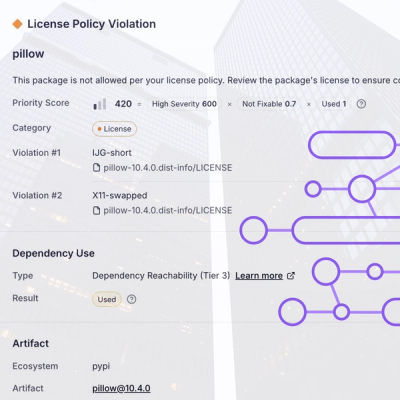
Product
Customize license detection with Socket’s new license overlays: gain control, reduce noise, and handle edge cases with precision.